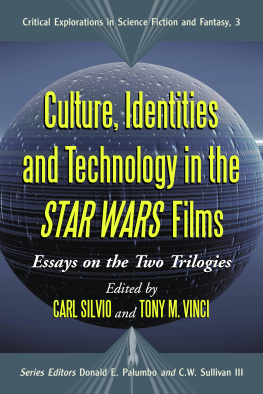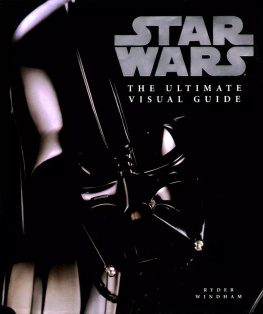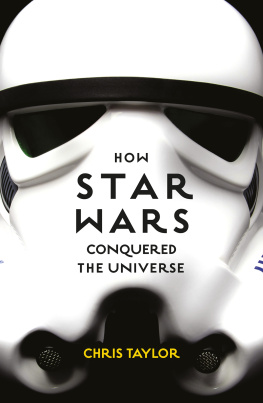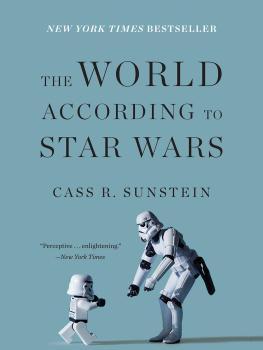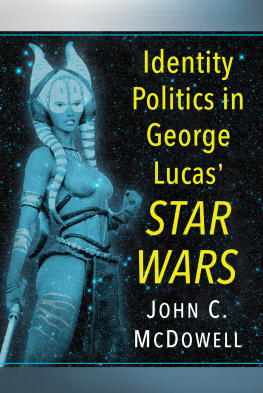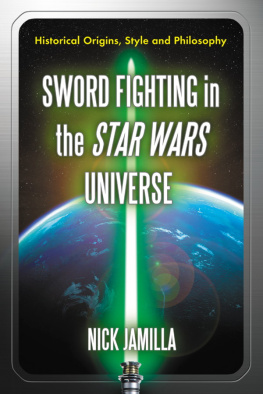Culture, Identities and Technology in the Star Wars Films
Essays on the Two Trilogies
EDITED BY CARL SILVIO AND TONY M. VINCI
CRITICAL EXPLORATIONS IN SCIENCE FICTION AND FANTASY, 3
Donald E. Palumbo and C.W. Sullivan III, series editors

McFarland & Company, Inc., Publishers
Jefferson, North Carolina
CRITICAL EXPLORATIONS IN SCIENCE FICTION AND FANTASY (a series edited by Donald E. Palumbo and C.W. Sullivan III)
Worlds Apart? Dualism and Transgression in Contemporary Female Dystopias (Dunja M. Mohr, 2005)
.Tolkien and Shakespeare: Essays on Shared Themes and Language (edited by Janet Brennan Croft, forthcoming 2007)
Culture, Identities and Technology in the Star Wars Films: Essays on the Two Trilogies (edited by Carl Silvio and Tony M. Vinci, 2007)
The Influence of Star Trek on Television, Film and Culture (edited by Lincoln Geraghty, forthcoming 2007)
Hugo Gernsback and the Century of Science Fiction (Gary Westfahl, forthcoming 2007)
LIBRARY OF CONGRESS CATALOGUING DATA ARE AVAILABLE
BRITISH LIBRARY CATALOGUING DATA ARE AVAILABLE
e-ISBN: 978-1-4766-1106-8
2007 Carl Silvio and Tony M. Vinci. All rights reserved
No part of this book may be reproduced or transmitted in any form or by any means, electronic or mechanical, including photocopying or recording, or by any information storage and retrieval system, without permission in writing from the publisher.
Cover image 2007 Brand X Pictures
McFarland & Company, Inc., Publishers
Box 611, Jefferson, North Carolina 28640
www.mcfarlandpub.com
Introduction
Moving Away from Myth: Star Wars as Cultural Artifact
Few popular filmic narratives have so captivated the publics imagination and invited as much critical commentary as George Lucass Star Wars series. First released in May of 1977, Episode IV: A New Hope (then, simply entitled Star Wars) quickly became the highest grossing film of all time as it redefined the cinematic use of special effects and ushered in a new era of the Hollywood blockbuster. With the release of each subsequent film in the franchise, the publics fascination with and affection for Lucass creation grew in scope and depth. The films, numbering six at the time of this writing, now command a fan-base of millions worldwide and have generated scores of supplemental narratives in the form of novels, television shows, a holiday special, fan fiction, and more. The two Star Wars trilogies now stand as the deep core of an expanded universe that constantly evolves and changes with the addition of each new thread to its heterocosmic tapestry. This textual universe serves as one of our societys richest repositories of contemporary myth and social meaning, a galaxy where collective hopes and anxieties are both revealed and imaginarily resolved.
Since 1977, the majority of Star Wars criticism has focused on the films use of mythic archetypes and trans-cultural, pan-human themes. In 1978, scarcely a year after the release of the first film, Andrew Gordon published his seminal essay, Star Wars: A Myth for Our Time. In this text, Gordon attempted to account for the popularity of the film by explaining it in terms of the theories of Joseph Campbell and his extraordinarily influential idea of the monomyth. According to Gordon, Lucas translated certain universal mythic patterns, templates of human meaning, into the idiom of contemporary popular culture and, in so doing, provided viewers with a profound degree of emotional and philosophical satisfaction that was presumably missing from their lives: Lucas has constructed out of the usable past, out of bits of American pop culture, a new mythology which can satisfy the emotional needs of both children and adults (324). Gordon defines myth as a story, or set of stories, that explains our place in the world and helps us to understand and express our relationship to a broader humanity. Mythology, then, encourages an identification with patterns of meaning that transcend our immediate social context; mythology allows us to experience our individual existences as significant in a universal or trans-historical sense. Claiming that the films retell one of the central epic myths of Western culturethe story of a fall, a wandering, and an eventual returnDavid Wyatt expressed a similar idea in another early scholarly work on Star Wars (600). Accordingly, this mythic pattern imaginatively captures some common framework of (Western) human experience that is broader than our own individual experiences but within which our localized existences can be made to assume a deeper and more satisfactory meaning.
Lucas makes no secret of his interest in mythology or the fact that he drew heavily from such sources, the chief of which was Campbell, in producing his vision. Thus, interpretations of Star Wars like those of Gordon and Wyatt seem logical and appropriate in the approaches that they take to the films. In fact, such approaches worked so well that they shaped most of the subsequent scholarly work on this film series by establishing mythology and myth criticism as the explanatory modes best suited to understand the films pervasive appeal to at least two generations of audiences and to elucidate the intricate semiotic patterns that Lucas has created. Jungian and Freudian approaches to the trilogies are also quite common, insofar as these schools of thought, like mythology, tend to posit shared, trans-cultural narrative explanations for human experience. This sort of critical work has found eager audiences in non-academic circles as well. In 1997, the Star Wars and the Magic of Myth exhibit premiered at the Smithsonian Institutions National Air and Space Museum. This exhibit, along with its companion book of the same title by Mary Henderson, was phenomenally popular, so popular that the exhibit went on to tour the country after it closed in Washington in 1999. In the publics imagination, the terms Myth and Star Wars are very closely linked.
But in 1978, the same year that Gordon published his highly influential essay, Dan Rubey published another, less well known but by no means less significant, article on Star Wars that treated the film and its use of mythology very differently. In Star Wars: Not So Long Ago, Not So Far Away, Rubey argued that Lucass picture of an unbroken tradition of adventure mythology stretching from Homer to John Ford ignores both the specific meanings these stories had for the societies which created them and the important differences between them. Myths and fantasies are not eternal; they are historical (89). Rubey suggests that the term mythology can assume a much more culturally specific and political meaning than is usually assigned to it. If mythology describes a process by which we come to understand our relationship to the universe through narrative, then the term can equally describe the wide variety of discursive processes that render our relationships to our immediate social universe meaningful. Mythology, in other words, also refers to a complex field of cultural production that both supports and can potentially contest the social production of belief. As Star Wars scholar Kevin J. Wetmore observes,
much myth criticism ignores the complicity of myth in establishing and maintaining social dominance and power structures. Many myths are created in order to explain why those in power are in power and why those who are oppressed or dominated are (and should be) oppressed and dominated [95].

